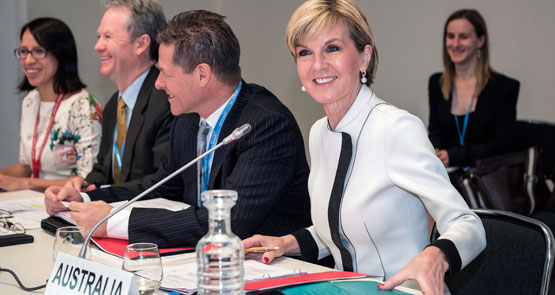
Trying to follow what happens at a climate summit is a bit like trying to swim up a waterfall. Negotiators are meeting behind closed doors, businesses are spruiking their wares, and NGOs are rushing from meeting to meeting, pushing governments to do more. It is a gushing torrent of ideas, advocacy and activity.
Foreign Minister Julie Bishop arrived in Paris on the weekend and hit the ground running. She delivered Australia’s ministerial statement to the rest of the world around lunchtime Monday. Her speech largely reiterated past statements by Prime Minister Malcolm Turnbull and committed to funding programs to help women engage in climate change decision-making (go to any energy policy conference in Australia and you will see why this is needed — they are all-male affairs). She reiterated that the “new agreement must promote further ambition and action over time”.
Building further action through time is one of the core ingredients for the outcome in Paris. Past climate agreements have not established a system for political leaders to regularly stand up among their peers to commit to do more. We saw the start of this process in advance of Paris when countries representing over 95% of global emissions put forward new emissions reduction targets. If implemented, we will be on a path for just under 3 degrees of global warming — better than the path of 4-6 degrees we were on before the Paris process.
From COP21 in Paris, most countries are trying to establish a system where countries will come back to the table every five years to update and progress their targets. This process will continue until we are on a pathway that limits warming to less than 2, or even 1.5 degrees.
In this regard, two things here are different from past summits.
First, the desire from most countries to deliver a durable agreement that can stand the test of time. Investors, communities and the climate can’t afford the time it will take for the global community to negotiate a brand-spanking new agreement every time they gather. So, future major summits should be more focused on stocktaking global action and finding ways to step it up, not be about reinventing international frameworks and rules every few years.
Secondly, never before has there been such recognition from a broad range of countries that warming of 2 degrees is too risky. So we need to consider limiting warming to less than even 1.5 degrees. This goal has created solidarity among many vulnerable countries in the developing world. Developed countries such as the USA, China, Australia and those within the European Union have also been open to recognising this in the agreement.
In her speech, Bishop re-iterated the messages from the government’s innovation statement. But when it comes to climate action that will avoid two, and let alone 1.5 degrees warming, national policies will matter as much as technological innovation. In Australia’s energy system, for example, all the best innovations will only be deployed around the edges — unless we have a plan to replace the ageing and inefficient coal-fired power stations that are blocking the modernisation of the power system.
As we enter the rapids of the last week of the Paris summit, we are in a position where the key elements exist for an outcome that can build on recent momentum and boost global action. A best possible outcome from the meeting is now possible. It is up to ministers to knuckle down and find the compromises that will deliver a durable agreement that keeps countries coming back to the table with stronger actions.







Very photogenic, our Julie oi, oi, oi.
It beggars understanding that world leaders & delegates are under the impression they actually have a choice.
It is interesting that at least five of those countries are developing SMRs, nuclear reactors for factory production, but we have yet to hear of an international commitment to distribute their mass production around the world.
Erwin (and devout Crikey Acolytes) at least the delegates in Paris (or hopefully most of them anyway) understand that there’s no easy /simple / non-painful remedy available to us, so why waste your time telling us / them there’s a problem for the Planet’s inhabitants?
Dodger – the poor of the Tird World allegedly clamouring for our coal could generate more electricity from domestic or village anaerobic sewage systems.
There are multiple more mobile telephones in India than toilets.
Better hope that they don’t go for your filthy nukes.